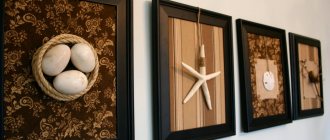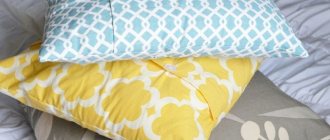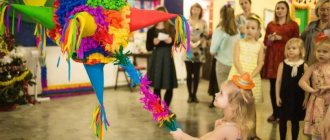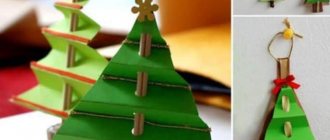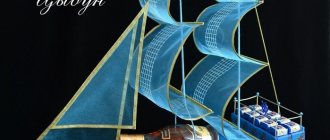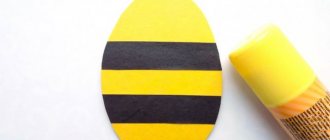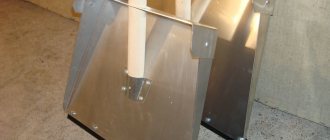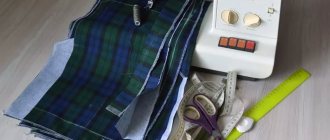Bird nests placed by birds on trees are cute and interesting, but homemade decorative crafts made from twigs like a house for birds are a completely different matter from the design sphere. The popularity of decorating the interior with such “fluffies” with toy eggs or figurines seated in them is becoming more and more widespread, which makes the algorithms for making them yourself more and more in demand.
Anyone can cope with this task, and the photos below of possible nests made from branches, options for using them in the interior, and recommendations for using such decorations will help with this.
Product options
Shapes and sizes can be very different: from a pocket gift nest to a full-size nest with the purpose of attracting storks to a summer cottage for nesting. Numerous photos of branch nests posted on the world wide web will help you make such crafts yourself.
Before starting work, you should decide on the purpose of the nest. Further instructions will help you understand how to make a nest for a stork with your own hands without outside help.
Required materials:
- tree shoots;
- bird feathers;
- hay, straw;
- thin rope or thread;
- glue, scissors;
- plastic plate or foam.
A finished decorative nest, intended for placement in the garden, can be painted, quail eggs, devoid of contents, can be placed inside, and then installed on a tree.
Decorating a mirror with branches
If you're tired of your old mirror and want to change it, don't rush. Using cuttings of branches, you can decorate your mirror, and it will sparkle with its beauty in a new form.
Mirror decorated with branch cuts
What is needed for this:
- Branches of different diameters.
- Wood file.
- Hot glue gun.
Work process:
- Let's get to work. Take the branches and make cuts with a saw of the same thickness.
- Then take a glue gun and glue each cut around the mirror. It will come out very original.
- In the same way, you can paste over vases and flower pots, or whatever suits your imagination.
You can also use small planks to make a wooden frame like this for a mirror - LESSON here!
Beginning of work
The basis can be a round plastic blank made from a disposable plate or polystyrene foam. Small branches are attached to it using glue, which are attached to the base with a thin thread.
Then bundles of hay or straw are placed and glued on top of the branches, which are held together with threads for strength. Using scissors, the nest is trimmed, the inner surface is smeared with glue and a layer of hay is placed on it.
For authenticity, you can place bird eggs or their imitation in the nest. In particular, quail eggs look good, the contents of which can be blown out or eaten.
For a fabulous effect, walnuts painted with gold or silver paint, as well as table tennis balls, are suitable.
Round-shaped stones are also suitable for these purposes. You can buy small chicks in the gift shop and place them in the nest along with the eggshells.
Metal threads and feathers of fantastic birds taken from hairpins are also used.
Decoration for mirrors
An interesting decor can be made from a round mirror. Instead of a frame, elements made from pieces of wood are attached. This option looks great in a loft interior. You can complement the mirror with themed accessories.
The frame of long branches looks unusual.
Popularity of storks in Ukraine
Another legend says that these birds brought bunches of grapes to the Zaporozhye Cossacks in Tatar captivity and thereby saved them from hunger. There are similar legends in Moldova, where this bird is a symbol of viticulture.
- A DIY mailbox is a beautiful decoration and a useful addition to a suburban area
A house for children is a place where a fairy tale becomes reality, we create it ourselves
- Bridges for a dacha - a picturesque element of the landscape in a suburban area
Sculptures of storks have recently become increasingly common in cities, villages, courtyards and dachas. The sculpture of a stork on the site not only serves as decoration, but is also a way of self-expression for the owners of the territory.
The variety of compositions with storks allows you to choose the one you need, showing your taste and aesthetic imagination.
Preparing material for crafts
Natural materials are available and practically free. You can collect branches while walking in the park, in the forest, at the dacha, or just on the street. It is better to stock such material in spring or autumn.
What should you pay attention to when choosing?
- It is better to choose clean, straight and even branches and twigs. It’s more convenient to work with them.
- Branches damaged by pests, rotten, and showing signs of disease are not suitable for crafts.
- The branches of coniferous trees are too resinous. This will make the job more difficult. Resin is difficult to clean from working tools and hands.
Processing of wood material
Twigs, twigs, branches, and snags brought home require additional processing. First, they need to be carefully examined again for bug damage and disease. Suspicious branches should be disposed of.
Then the branches should be washed and smoothed with sandpaper for leveling.
All blanks for future crafts require drying. It is better to start it right away. Otherwise, the appearance of the finished product may suffer.
- Drying naturally occurs at room temperature. It lasts about two weeks.
- Twigs and branches can be dried on a radiator. In this case, the material will be ready for use in a week.
- You can dry it even faster in the oven. On low heat, with the oven door slightly open, you can get the finished material in a couple of hours.
After drying, it is a good idea to cover the branches with colorless varnish, paint or stain them, depending on the final design.
Making a nest for a stork
Creating an imitation nest from branches with your own hands is quite simple. Such a composition, when using real branches, will look much more attractive than a sculpture purchased in a retail chain.
Through this process, which requires patience and focus, true creative satisfaction can be obtained.
The following description will help you understand how to make your own nest from branches. Young branches that do not break and are more flexible than old or dried ones are more suitable for making a nest.
It should be noted that there is a ready-made metal base on sale, to which you can easily attach a vine, and its design includes parts that secure the lower part of the sculpture. To give special stability to the figure, its metal legs are welded to the base.
The sculpture can be placed in the following places:
Roofs. The nest is attached to the rafters using nails or screws.
Trees and stumps. Trees can be cut down not at the root, but higher from the ground. On such a high stump, the figure of a stork will make an indelible impression.
After installing the nest, you should attach the stork figure to it using fishing line that will not be noticeable. In strong winds, the sculpture should be secured with additional supports.
Wall layout
It all depends on your patience and time. It’s better to make a layout before you disfigure the wall with tags and hooks. There are two ways:
- You can lay out objects on the floor/table and change their places until the composition comes together. Then we apply each object to the wall in the planned place and trace it along the contour, so you get something like a gallery pattern right on the wall - and you can evaluate whether your scheme works or not before hanging the objects.
- I do it differently: when all the objects are purchased and made, I cut out their mini-layouts from graph paper and lay them out on a wall model, also drawn on graph paper. I change places, remove something, add something, etc. When the layout is assembled and ready, I simply transfer it to the wall, and that’s it.
Photo: conceptbyanna.tumblr.com.
Features of the placement of the stork figure
On the ground, it is advisable to place the sculpture in a well-lit place, not far from the bushes.
If there is a pond on the site, then the sculpture of a stork will give it additional attractiveness.
A stork in a nest personifies family values and therefore such a sculpture should be installed in the place where the family spends most of its time.
The figure should be positioned so that the stork's head is directed towards the house, not away from it.
Step-by-step instruction
Twist one twig into a tight ring, leaving a small hole in the center. Take an odd number of other branches (preferably more than five) and secure them to the ring with a rope.
Start circular weaving according to the basket principle: first pass the twig under the jumper, then over it. Secure the ends of the branches with twine, and after finishing, continue weaving from where you stopped.
Fill the missing spaces with branches, grass, feathers or down.
Place decorated eggs or bird figurines in the formed bed.
Break the branches into small sticks two to five centimeters long.
Inflate the balloon and tie it tightly. Coat the ball with a generous layer of glue.
Place broken branches on the surface in a chaotic manner, repeating the shape of the nest. Deflate the balloon and release the fake.
Supplement the product with rods and other decorative elements as desired.
Nest
For many peoples, the stork symbolizes good luck, peace and prosperity. Therefore, rural residents have always sought to attract storks to their yard to hatch chicks.
If there are no conditions for nesting storks in your area, you can make his figure yourself.
To attract storks, a nest should be built no further than 1-2 km from its feeding areas (swamps, water meadows) and no closer than 0.2-0.3 km from existing nests, to avoid conflicts between birds.
The place for the nest should be chosen so that nothing interferes with the stork’s approach. The nest is built at a height of 4-10 m as far as possible from power lines. In this case, the socket support must withstand a load of 30-40 kg.
The frame for the nests can be bicycle wheels, welded steel reinforcement, platforms made of poles, boards.
On the platform, it is necessary to make an imitation of an old nest from dried branches in a layer of 0.2-0.3 m, and place straw and dried manure in the center.
Bunches of brushwood can be secured next to the nest, and the edges can be sprayed with lime to make it look more like droppings.
In the Non-Black Earth Region, storks nest mainly on trees and poles.
In trees, nests are placed on sawn-off tops or on a large side branch near the trunk. Branches that interfere with the approach should be cut down.
At the top of a tree that has a fork, you can cut off the branches at the base and make a platform at the fork.
Master class on how to make an Easter nest with your own hands
The Easter nest has surprisingly many faces. This can be a decorative craft using a variety of techniques, or special baked goods. It is with the sweet nest that I will begin the story about this unusual decoration.
The nest is baked from rich yeast dough.
It has the shape of a twisted donut, in the center of which a colored egg is inserted, so the finished delicacy becomes like a nest. In order to bake it, we will need:
- flour – 2 cups;
- eggs - 1 piece;
- milk – 150 milliliters;
- sugar – 4 tablespoons;
- raisins – 100 grams;
- dry yeast – 10 grams.
Step 1. We start by preparing the dough. Heat the milk to 40°C, dissolve the yeast and sugar in it, add one glass of flour, stir until smooth. Cover the bowl with the mixture with a towel or cling film and place in a warm place for about 60 minutes.
Step 2. Add the rest of the flour to the risen dough, cover the bowl with the dough again and leave to rise for another hour.
Step 3. While the dough is maturing, prepare the raisins. We wash it, steam it, then pour boiling water over it and let it stand for 10 minutes. Place the raisins in a sieve, let the liquid drain, and lay them out to dry on napkins.
Step 4. Add raisins to the ripened dough and knead. Pinch off small pieces of dough and roll them into long thin ropes.
Step 5. Take two flagella, intertwine them with each other, and roll them into a ring. This will be our “nest”. The diameter must be selected so that a chicken egg can be installed in the hole.
Step 6. For the final rise of the dough, let the nests stand for 10 minutes, then brush the surface with beaten egg and bake them in the oven, which we preheat to 180°C. Baking time 15–20 minutes.
Step 7. Let the finished nests cool completely, and insert a colored egg into each.
Nest designs
- Pillars made of any material can serve as support for the nests.
- The wooden base for the roof nest is made from boards nailed to the crosspieces and then attached to the roof ridge.
- On top of this base, a platform, grate or wheel is attached with nails.
Only professionals can arrange a site for black stork nests.
How many nests do you need to make?
It depends on you, but it is advisable to do 2-3 of them, no more. You don't want to attract too many birds to your yard, otherwise they may often disturb you with their singing when you want to be completely alone.
Although, it’s up to everyone’s discretion: for some it’s suitable, for others it’s not. Remember, comfort is the most important thing in such places.
Stork made of plastic bottles
Templates for the body and wings of the stork are cut out of plywood. To work, you will need plastic bottles of dark and light colors, screws and electrical tape.
- The templates are fastened with screws.
- Strips of white plastic, simulating feathers, are cut from milk bottles.
- The feathers are glued to the stork's body.
- Black stripes are used for the tail.
- The beak is wrapped with red electrical tape.
- The material for the legs can be wire, and the eyes can be purchased at a specialized store.
Where can I place it?
In the house. You can decorate any room in an apartment or house with a nest - the personification of comfort, family and warmth. The decoration looks especially good with a container of cereal or painted eggs placed in it.
As a present. A standard packaging box with a bow or a boring package is nothing compared to a bird's nest design. To give it a festive look, all you have to do is sprinkle the craft with glitter and add a shiny ribbon to the weave.
https://www.youtube.com/watch{q}v=S0LSHb4uIPU
We invite you to familiarize yourself with: Do-it-yourself composition of feed for turkeys
A decorative nest is one of those crafts whose simplicity of manufacture hides originality, practicality and incredible aesthetics. All that remains is to find suitable branches to decorate the interior of the living room or garden with an original accessory.
Tags: nest, thread, hand, yours, make
About the author: admin4ik
« Previous entry
Polyurethane foam stork
- The body parts are attached with tape to a plastic base.
- A beak is made from a nail.
- The legs of the figure can be made of steel reinforcement, electrodes or wire.
- The base is covered with polyurethane foam.
- Excess foam is then cut off.
- The figure is covered with acrylic paints.
- A nose made of wood is attached to the nail.
- The tail and wings are covered with feathers.
A stork sculpture is made in a similar way from a plastic canister, bottles and foam.
For tendril-bearing plants - vertical and horizontal supports
When using heavier vines, not only vertical, but also horizontal rails must be reliable. Even a gazebo or a gazebo or pavilion can be designed with plants. It is also worth considering the weight of the stems for cultivated plants - fruits or berries. This helps avoid disturbances during active growth or harvest.
These designs are suitable for antennas such as:
- Clematis;
- Grape;
- passionate flora;
- Laginaria;
- Rating.
